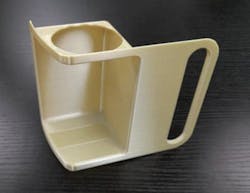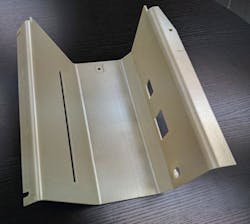3-D printers get a lift from aviation industry
An Asian tooling fabrication and molding company is embracing 3-D printing as a way to meet challenging on-time orders for airlines. Getting the effort off the ground is a new, aerospace-focused package from Stratasys.
Stratasys spokesman Joe Hiemenz said the company's new Aircraft Interiors Certification package now is ready for takeoff. It features a specially configured Fortus 900mc printer, as well as software and process-control documentation, all designed to make compliance easier for manufacturers.
To meet Federal Aviation Administration (FAA) and European Aviation Safety Agency (EASA) requirements, the fused-deposition-modeling (FDM) printer has undergone an upgrade. "The extrusion head tip's internal and external shape has been redesigned to reduce variability of the extrusion, making the process more accurate and repeatable," he said.
Based in Hong Kong, molder Western Tool & Mold is an early adopter of the new package. Managing Director Collin Wilkerson said it will expedite production of cabin parts. "Adding the Stratasys Fortus 900mc Aircraft Interiors Certification edition to our extensive arsenal of Stratasys FDM and PolyJet-based 3-D printing solutions not only gives us the opportunity to provide repeatable, certified aircraft parts to Tier 1 and Tier 2 aircraft parts suppliers, but also the accompanying documentation process is now automated, making it easier to meet evolving industry quality standards while freeing up more time to invest in production."
Stratasys' release comes as interest continues to grow among aircraft parts manufacturers in additive manufacturing machines' ability to produce low-volume parts without the need for expensive tooling.
Using FDM, the 900mc builds parts layer by layer from the bottom up by heating and extruding material. The 6,325-pound machine boasts two build zones within an area measuring 36 inches by 24 inches by 36 inches. Pairs of build-material canisters and support-material canisters deliver resin to the machine, which is capable of making parts with layer thicknesses as thin as 0.007 inch.
The 900mc can produce parts with the extreme repeatability that is required by the FAA, with an accuracy of within 0.0035 inch or better, depending on final part size.
Using aerospace-approved Ultem 9085, a thermoplastic polyetherimide, it can print low-volume aircraft cabin parts with complex geometries, such as overhead bin lockers and fixtures for restrooms.
Leo Christodoulou, enterprise technology strategy leader for Boeing, which uses in-house additive manufacturing technologies as well as third-party innovations, said the field continues to evolve.
Additive manufacturing, he said, "offers great potential to reduce the cost and weight of aircraft structures and improve the ability of engineers to design parts purely for their eventual function in a vehicle system." He noted that Boeing continues research on several fronts, with technologies that include FDM, selective-laser sintering, direct-metal-laser sintering, electron-beam melting and stereolithography.
"3-D printing enables the design and production of integral structures," Christodoulou said. "This means converting an assembly and several structures into one piece."
Currently, Boeing has about 50,000 3-D printed parts in the air, including wiring brackets and ducts.
For Western Tool & Mold's customers, 3-D printing could result in significantly lower costs, Stratasys said, because it eliminates the need for tooling.Hiemenz pointed out other benefits as well, noting that 3-D printing can handle complex parts with ease, and swapping designs is as simple as changing CAD files.Stratasys' new aerospace package eliminates obstacles for manufacturers, Hiemenz said.
"The benefit of this solution is that it removes complexity from getting FAA and EASA certification — helping aircraft makers get more parts certified faster," he said.
3D Systems
The price of an additive manufacturing machine that can be used by aerospace manufacturers has been reduced.
3D Systems announced in April that it had lowered the price of its ProX SLS 500 by more than 30 percent. According to a press release, the SLS machine now carries a base price around $285,000.
It uses a laser to fuse powdered material and has a maximum build envelope of 15 inches of 13 inches by 18 inches. Featuring automated powder handling, it can use a variety of materials from the DuraForm line, from tough nylon to glass-filled engineering plastic.
Karen Hanna, copy editor
For more information
3D Systems Inc.,Rock Hill, S.C., 803-326-3930, www.3dsystems.com
Boeing Co.,Chicago, 312-544-2000, www.boeing.com
Stratasys Ltd.,Eden Prairie, Minn., 877-489-9449, www.stratasys.com
About the Author
Karen Hanna
Senior Staff Reporter
Senior Staff Reporter Karen Hanna covers injection molding, molds and tooling, processors, workforce and other topics, and writes features including In Other Words and Problem Solved for Plastics Machinery & Manufacturing, Plastics Recycling and The Journal of Blow Molding. She has more than 15 years of experience in daily and magazine journalism.



